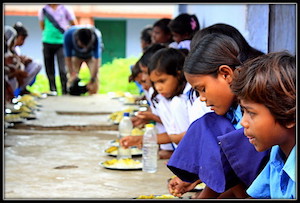We conducted a third round of community surveys on the Mobile Vaani network in Bihar, Jharkhand, Madhya Pradesh, and Uttar Pradesh, this time with a greater focus on child nutrition security through the mid-day meal and Anganwadi services. A summary of results from Bihar is below. Other states did not fare much better. The poor state of services delivery stands the risk of reversing the gains made in nutrition over the last several years. Links to our earlier rounds of community surveys are here: Round #1 – April 2020, Round #2 – June 2020.
- 68% respondents have not received dry rations or any monetary assistance in lieu of mid day meals in schools.
- Of those who received some benefits, 80% have received a monthly ration kit comprising of only wheat and rice, while only 9% received dry ration along with cost for cooking, and another 11% received cash transfers in lieu of mid day meals.
- Of those who received some benefits, 64% respondents were satisfied by the quantity and quality of rations and the amount of money received in lieu of mid day meals. 31% however were not satisfied and they found the quantity of ration or the amount provided to be less.
- Of those who did not receive any assistance, 76% parents say that they are finding it hard to provide good quality food to their children and are managing somehow, while 17% are unable to provide good quality food.
- 77% of the respondents who have children enrolled in Aanganwadi centers have not received any provisions from the centers.
- Of those who have received assistance, 80% found distributed ration to be of good quality while 15% said that the quantity was not enough.
- Of those who did not receive any assistance from Aanganwadi centers, 85% respondents say that they are managing somehow with whatever food that is available at home. 10% are unable to provide good quality food to their children.
- As far as agriculture land, kitchen garden or availability of livestock is concerned, 79% respondents do not have any of these which can help them in managing nutritious food for the household.
- At times, family members including children even had to skip meals or cut down on the food amounts because of affordability reasons. 47% respondents said that they faced this situation.



